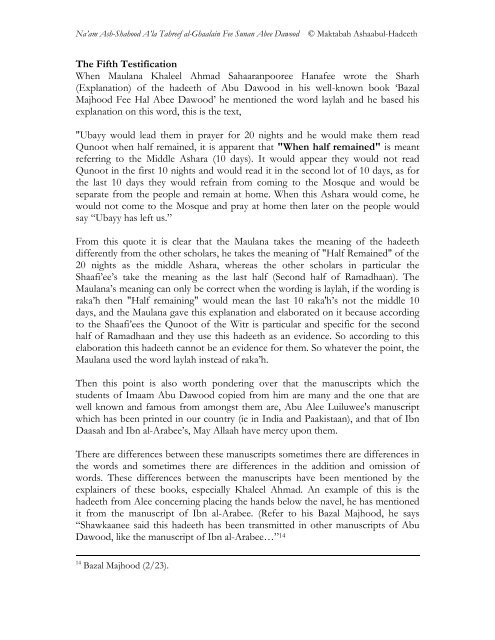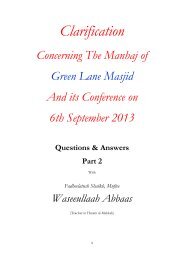na'am as-shahood a'la tahreef al - Ahlul hadeeth
na'am as-shahood a'la tahreef al - Ahlul hadeeth
na'am as-shahood a'la tahreef al - Ahlul hadeeth
You also want an ePaper? Increase the reach of your titles
YUMPU automatically turns print PDFs into web optimized ePapers that Google loves.
Na’am Ash-Shahood A’la Tahreef <strong>al</strong>-Gha<strong>al</strong>ain Fee Sunan Abee Dawood © Maktabah Ashaabul-Hadeeth<br />
The Fifth Testification<br />
When Maulana Kh<strong>al</strong>eel Ahmad Sahaaranpooree Hanafee wrote the Sharh<br />
(Explanation) of the <strong>hadeeth</strong> of Abu Dawood in his well-known book ‘Baz<strong>al</strong><br />
Majhood Fee H<strong>al</strong> Abee Dawood’ he mentioned the word laylah and he b<strong>as</strong>ed his<br />
explanation on this word, this is the text,<br />
"Ubayy would lead them in prayer for 20 nights and he would make them read<br />
Qunoot when h<strong>al</strong>f remained, it is apparent that "When h<strong>al</strong>f remained" is meant<br />
referring to the Middle Ashara (10 days). It would appear they would not read<br />
Qunoot in the first 10 nights and would read it in the second lot of 10 days, <strong>as</strong> for<br />
the l<strong>as</strong>t 10 days they would refrain from coming to the Mosque and would be<br />
separate from the people and remain at home. When this Ashara would come, he<br />
would not come to the Mosque and pray at home then later on the people would<br />
say “Ubayy h<strong>as</strong> left us.”<br />
From this quote it is clear that the Maulana takes the meaning of the <strong>hadeeth</strong><br />
differently from the other scholars, he takes the meaning of "H<strong>al</strong>f Remained" of the<br />
20 nights <strong>as</strong> the middle Ashara, where<strong>as</strong> the other scholars in particular the<br />
Shaafi’ee’s take the meaning <strong>as</strong> the l<strong>as</strong>t h<strong>al</strong>f (Second h<strong>al</strong>f of Ramadhaan). The<br />
Maulana’s meaning can only be correct when the wording is laylah, if the wording is<br />
raka’h then "H<strong>al</strong>f remaining" would mean the l<strong>as</strong>t 10 raka'h’s not the middle 10<br />
days, and the Maulana gave this explanation and elaborated on it because according<br />
to the Shaafi’ees the Qunoot of the Witr is particular and specific for the second<br />
h<strong>al</strong>f of Ramadhaan and they use this <strong>hadeeth</strong> <strong>as</strong> an evidence. So according to this<br />
elaboration this <strong>hadeeth</strong> cannot be an evidence for them. So whatever the point, the<br />
Maulana used the word laylah instead of raka’h.<br />
Then this point is <strong>al</strong>so worth pondering over that the manuscripts which the<br />
students of Imaam Abu Dawood copied from him are many and the one that are<br />
well known and famous from amongst them are, Abu Alee Luiluwee's manuscript<br />
which h<strong>as</strong> been printed in our country (ie in India and Paakistaan), and that of Ibn<br />
Da<strong>as</strong>ah and Ibn <strong>al</strong>-Arabee’s, May Allaah have mercy upon them.<br />
There are differences between these manuscripts sometimes there are differences in<br />
the words and sometimes there are differences in the addition and omission of<br />
words. These differences between the manuscripts have been mentioned by the<br />
explainers of these books, especi<strong>al</strong>ly Kh<strong>al</strong>eel Ahmad. An example of this is the<br />
<strong>hadeeth</strong> from Alee concerning placing the hands below the navel, he h<strong>as</strong> mentioned<br />
it from the manuscript of Ibn <strong>al</strong>-Arabee. (Refer to his Baz<strong>al</strong> Majhood, he says<br />
“Shawkaanee said this <strong>hadeeth</strong> h<strong>as</strong> been transmitted in other manuscripts of Abu<br />
Dawood, like the manuscript of Ibn <strong>al</strong>-Arabee…” 14<br />
14 Baz<strong>al</strong> Majhood (2/23).



